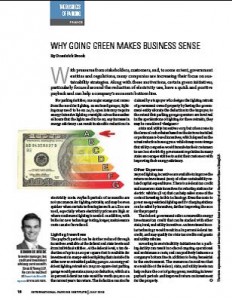With pressures from stakeholders, customers, and, to some extent, government entities and regulations, many companies are increasing their focus on sustainability strategies. Along with these motivations, certain green initiatives, particularly focused around the reduction of electricity use, have a quick and positive payback and can help a company’s economic bottom line.
For parking facilities, one major energy cost comes from the need for lighting. In enclosed garages, lighting may need to be on 24/7; open lots may require energy-intensive lighting overnight. Given the number of hours that the lights need to be on, any increase in energy efficiency can result in sizeable reductions in electricity costs. Payback periods of 18 months are not uncommon for lighting retrofits, and may be even quicker when certain technologies such as LEDs are used, especially where electricity prices are high or where continuous lighting is needed. In addition, with bulbs for new technology lasting longer, maintenance costs can also be reduced.
Lighting Incentives
The payback period can be further reduced through incentives available at the federal and state levels and from individual utilities. At the federal level, a tax deduction of up to $0.60 per square foot is available for investments in energy-efficient lighting that’s installed in either new or retrofitted parking garages. An energy-efficient lighting retrofit of a 250,000-square-foot parking garage would generate a $150,000 deduction, which at a 35 percent federal tax rate would be worth $52,500 on the current year’s tax return. The deduction can also be claimed by a taxpayer who designs the lighting retrofit of government-owned property by having the government entity allocate the deduction to the taxpayer; to the extent that parking garage operators are involved in the specifications of lighting for these retrofits, they may be considered “designers.”
State and utility incentives vary, but often come in the form of cash rebates based on the fixtures installed or performance-based incentives, which depend on the actual reduction in energy use. While it may seem strange that utility companies would incentivize their customers to use less electricity, government regulation in many states encourages utilities to assist their customers with improving their energy efficiency.
Other Expenses
Beyond lighting, incentives are available to improve the return on investment (ROI) of other sustainability-related capital expenditures. There is a federal tax credit and numerous state incentives for refueling stations for electric vehicles (EVs) that can help offset some of the costs of investing in this technology. Even the costs to power energy-efficient lighting and EV charging stations can be offset by incentives, further improving the ROI for the property.
The federal government offers a renewable energy investment tax credit that can be stacked with other state, local, and utility incentives. An investment in solar technology would result in a 30 percent federal tax credit, and may qualify for state tax credits and grants and utility rebates.
Investing in sustainability initiatives for a parking facility can result in reduced ongoing operational and maintenance costs, and can positively influence a company’s bottom line in addition to being beneficial to the environment. The numerous incentives that are available at the federal, state, and utility levels can help reduce the cost of going green, resulting in lower payback periods and improved return on investment for the property.
Dominick Brook is senior manager, tax credit and investment advisory services with Ernst & Young LLP. He can be reached at Dominick.Brook@ey.com or 614.232.7376.
TPP-2013-07-Why Going Green Makes Business Sense

